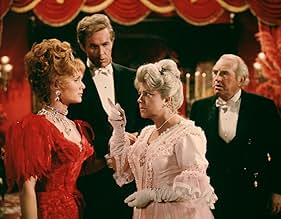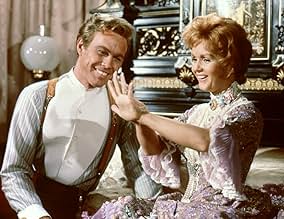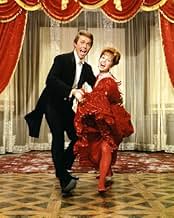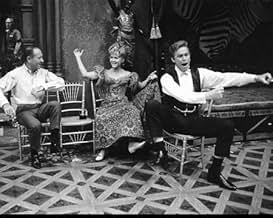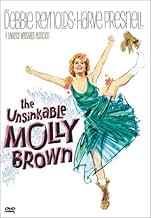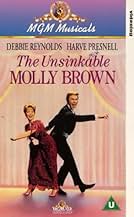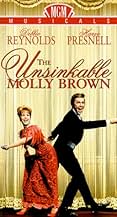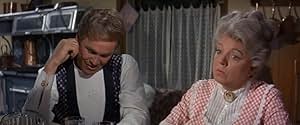CALIFICACIÓN DE IMDb
6.6/10
4.5 k
TU CALIFICACIÓN
Una montañesa pobre y sin educación abandona su cabaña en busca de respeto, un marido rico y una vida mejor en esta película biográfica ficticia sobre Margaret "Molly" Brown, quien sobrevivi... Leer todoUna montañesa pobre y sin educación abandona su cabaña en busca de respeto, un marido rico y una vida mejor en esta película biográfica ficticia sobre Margaret "Molly" Brown, quien sobrevivió al hundimiento del Titanic en 1912.Una montañesa pobre y sin educación abandona su cabaña en busca de respeto, un marido rico y una vida mejor en esta película biográfica ficticia sobre Margaret "Molly" Brown, quien sobrevivió al hundimiento del Titanic en 1912.
- Dirección
- Guionistas
- Elenco
- Nominado a 6 premios Óscar
- 5 premios ganados y 13 nominaciones en total
- Dirección
- Guionistas
- Todo el elenco y el equipo
- Producción, taquilla y más en IMDbPro
Opiniones destacadas
"The Unsinkable Molly Brown" made its debut on Broadway in 1960. Tammy Grimes, as the Molly Brown of the title, received, perhaps, the best reviews of her acting career. When it was made into an MGM musical, Miss Grimes, lost her creation to Debbie Reynolds, who had a bigger name and was a favorite of the movie going public.
Meredith Wilson, the man behind another hit, "The Music Man", created a musical comedy that showcased a fictionalized account of the larger than life character of Molly, a woman who went from humble beginnings to bigger, and better things. As a matter of fact, she was truly "unsinkable" as proved by having survived the Titanic disaster.
Not having seen this film for quite some time, didn't quite make it for this viewer, on a second viewing, in spite of glowing comments from other IMDb contributors. However, it must be noted, our memory of having seen it before was more positive than the impression we got in watching it again. Part of the problem is the plot, which is silly, in the way the material is presented. Then again, this film has a dated feeling.
Debbie Reynolds threw herself into the role of Molly with gusto. It's one of her best achievements in the movies, and it should be recognized. Herve Presnell, who played Johnny Brown on Broadway, seemed destined for bigger and better things, as he shows here with his handsome looks and powerful singing voice. The cast includes several character actors that enhance the movie, notably, Ed Begley, Hermione Baddeley, Jack Krushen and Martita Hunt, among others.
The film could be seen as a curiosity, although it shows its age. The songs, with only a few exceptions don't have the quality of other Meredith Wilson's work. Only a couple of songs stay with the viewer after all is said and done. Charles Walters' direction was not too inspired and perhaps that seems to be the basic flaw with this "Molly".
Meredith Wilson, the man behind another hit, "The Music Man", created a musical comedy that showcased a fictionalized account of the larger than life character of Molly, a woman who went from humble beginnings to bigger, and better things. As a matter of fact, she was truly "unsinkable" as proved by having survived the Titanic disaster.
Not having seen this film for quite some time, didn't quite make it for this viewer, on a second viewing, in spite of glowing comments from other IMDb contributors. However, it must be noted, our memory of having seen it before was more positive than the impression we got in watching it again. Part of the problem is the plot, which is silly, in the way the material is presented. Then again, this film has a dated feeling.
Debbie Reynolds threw herself into the role of Molly with gusto. It's one of her best achievements in the movies, and it should be recognized. Herve Presnell, who played Johnny Brown on Broadway, seemed destined for bigger and better things, as he shows here with his handsome looks and powerful singing voice. The cast includes several character actors that enhance the movie, notably, Ed Begley, Hermione Baddeley, Jack Krushen and Martita Hunt, among others.
The film could be seen as a curiosity, although it shows its age. The songs, with only a few exceptions don't have the quality of other Meredith Wilson's work. Only a couple of songs stay with the viewer after all is said and done. Charles Walters' direction was not too inspired and perhaps that seems to be the basic flaw with this "Molly".
I used to watch this movie when I was little, and I just recently rediscovered it. It's amazing how much better movies can get once you grow up. Debbie Reynolds portrays Molly Brown wonderfully. Her singing and dancing alone make this movie worth watching. My favorite scene is the "He's my friend, and he'll stay my friend...." scene. If you haven't seen this movie, you should definitely watch it. It's so great!
I don't know what it was, but I couldn't really get into this movie, be affected by it or enjoy it very much. Well, yeah, the society party scenes were a hoot, the scenery was pretty, the chereography of the "Friend" song was good, but that was about it. The rest was just... there, not horrible, but definitly not above average, either.
Debbie Reynolds should have been very well suited to the role of Molly Brown, but for all her teeth-gritting, yelling, and wailing, she just doesn't rise to the occasion. Why this is often considered her best role, and why she was nominated for an Oscar for it, I really couldn't tell you. Harve Presnell has a soaring voice, but again, just is average. The Merideth Willson score is rather pedestrian. (Apparently several songs were cut from the Broadway show; maybe they were better.) But really, this guy did The Music Man? And the Titanic sinking is done and dispensed with in maybe two minutes, if that. Come on! The one reason this musical was made was because of Mrs. Brown's legendary courage after that sinking. Not much evidence of that here. Oh, and yes, the musical is pretty accurate in terms of the many legends surrouding Margaret Brown, but not so faithful to the real person. (Many minute things: she was never rescued from a flood as a baby, she was actually born and raised in Hannibal, Missouri, her husband was always called J.J., never Johnny, they never really did reconcile, she actually had two children with him that were not mentioned, she never really was accepted by the Sacred Thirty-Six, her many contributions to the juvenile and suffrage movements were ignored as always, etc. and so forth. She was never even called Molly, always Margaret.) You get the point...
It simply wasn't anything special.
Debbie Reynolds should have been very well suited to the role of Molly Brown, but for all her teeth-gritting, yelling, and wailing, she just doesn't rise to the occasion. Why this is often considered her best role, and why she was nominated for an Oscar for it, I really couldn't tell you. Harve Presnell has a soaring voice, but again, just is average. The Merideth Willson score is rather pedestrian. (Apparently several songs were cut from the Broadway show; maybe they were better.) But really, this guy did The Music Man? And the Titanic sinking is done and dispensed with in maybe two minutes, if that. Come on! The one reason this musical was made was because of Mrs. Brown's legendary courage after that sinking. Not much evidence of that here. Oh, and yes, the musical is pretty accurate in terms of the many legends surrouding Margaret Brown, but not so faithful to the real person. (Many minute things: she was never rescued from a flood as a baby, she was actually born and raised in Hannibal, Missouri, her husband was always called J.J., never Johnny, they never really did reconcile, she actually had two children with him that were not mentioned, she never really was accepted by the Sacred Thirty-Six, her many contributions to the juvenile and suffrage movements were ignored as always, etc. and so forth. She was never even called Molly, always Margaret.) You get the point...
It simply wasn't anything special.
6B24
I had the pleasure of accompanying my great aunt and one of her contemporaries to the opening of this movie in Denver in 1964. Because they had known the old girl herself (the real Mrs. Margaret Brown, that is) back in the early years of the century, both in Leadville and Denver, they were keen on seeing what Hollywood and Debbie had done with the story.
I remember vividly watching their reactions turn from initial pleasure with the opening number to puzzlement when Debbie started to chew the scenery and behave like, well, Debbie Reynolds. This was followed by Ed Begley and the boys in the saloon hooting it up, and the two old ladies next to me started to frown a bit and whisper something to the effect that "it was not like that at all." They were becoming quite restless until the Denver bits began, but they seemed to accept the remainder of the story with a good deal of resignation that it was all just good fun and nonsense, and wasn't that what going to the movies was all about?
Afterward, as we strolled over to the Brown Palace for dinner, they regaled me with a complete history of the real Mrs. Brown and the many mutual friends they had enjoyed meeting at that same venue from roughly 1895 to 1915 when they were themselves just being presented into Denver society. I learned, among other things, that Mrs. Brown was considered an eccentric but generally well-liked and articulate woman who, despite never really being accepted at the toniest levels, became a legend in her own time after the Titanic episode. That part of the story was not only true, but actually a larger-than-life experience, the details of which they agreed should have been featured more profoundly in the film version.
The next time I drove down Wadsworth Blvd. and saw Mrs. Brown's "Summer House," a rather grand Victorian edifice like the better known one in the center of Denver, I tried to picture Debbie Reynolds in that setting and could not quite fit the two together. That in spite of the fact that Debbie herself grew up in El Paso at the southern end of the same Rocky Mountains that rise northward through Colorado.
I remember vividly watching their reactions turn from initial pleasure with the opening number to puzzlement when Debbie started to chew the scenery and behave like, well, Debbie Reynolds. This was followed by Ed Begley and the boys in the saloon hooting it up, and the two old ladies next to me started to frown a bit and whisper something to the effect that "it was not like that at all." They were becoming quite restless until the Denver bits began, but they seemed to accept the remainder of the story with a good deal of resignation that it was all just good fun and nonsense, and wasn't that what going to the movies was all about?
Afterward, as we strolled over to the Brown Palace for dinner, they regaled me with a complete history of the real Mrs. Brown and the many mutual friends they had enjoyed meeting at that same venue from roughly 1895 to 1915 when they were themselves just being presented into Denver society. I learned, among other things, that Mrs. Brown was considered an eccentric but generally well-liked and articulate woman who, despite never really being accepted at the toniest levels, became a legend in her own time after the Titanic episode. That part of the story was not only true, but actually a larger-than-life experience, the details of which they agreed should have been featured more profoundly in the film version.
The next time I drove down Wadsworth Blvd. and saw Mrs. Brown's "Summer House," a rather grand Victorian edifice like the better known one in the center of Denver, I tried to picture Debbie Reynolds in that setting and could not quite fit the two together. That in spite of the fact that Debbie herself grew up in El Paso at the southern end of the same Rocky Mountains that rise northward through Colorado.
This is not a review, but an inquiry. Does anyone know who the real-life baby was that portrayed Molly as a baby in the beginning of the movie going over the rapids in a cradle? I saw a very old "filler" once on TCM which featured swim instruction for very young children, some as young as 12 months. The instructor had them swimming to the pool bottom to retrieve items as well as racing each other to see who reached the other side first. I believe early swim instruction had gained some measure of popularity in California during the 30s. Most of the footage of the rapids was of a dummy. Other footage was of the baby in a water tank on a sound stage with footage of rapids being shown in the background. The final few seconds of that scene show the cradle overturning very close to shore and spilling the baby out. The baby then swims to shore and crawls out - that part is real. I sure would like to know who that baby was. It was precious!
¿Sabías que…?
- TriviaAs with most Hollywood biopics, there are liberties taken with the real story, most notably in that Margaret (Molly) and J.J. never reconciled. They separated in 1909, although they remained good friends who cared deeply for each other until his passing. She was also not quite the social outcast depicted in the film. Other aspects of her life that were missing from the movie: they had two children, a son and daughter. Margaret Brown was a passionate social crusader and philanthropist; she was a champion of women's rights, including education and the vote. She championed workers' rights, historic preservation, education and literacy, and child welfare, including helping to found the modern juvenile court system. After the sinking of the Titanic, she was noted for her efforts to commemorate the heroism of the men aboard the ship. After WWI, she helped to rebuild France and to aid wounded soldiers, and received the French Legion of Honor. She also ran twice for the U.S. Senate. She died in 1932.
- ErroresWhen Molly first meets John, in the 1880s, they look at some picture postcards she has with her. The picture occupies one entire side of each card, but postcards of this type were not available in the USA until 1907.
- Citas
Molly Brown: Nobody wants to see me down like I wants to see me up.
- Créditos curiososintroducing Harve Presnell
- Versiones alternativasIn the past, TCM has shown a version with Overture and Exit Music that ran 135 minutes. It also had a slightly different aspect ratio.
- ConexionesEdited from Y el mar los devoró (1953)
- Bandas sonorasOverture (Belly Up to the Bar, Boys/I Ain't Down Yet/I'll Never Say No/Colorado, My Home)
(uncredited)
Music and Lyrics by Meredith Willson
Performed by Robert Armbruster and The MGM Symphony Orchestra (as the MGM Studio Orchestra)
Selecciones populares
Inicia sesión para calificar y agrega a la lista de videos para obtener recomendaciones personalizadas
- How long is The Unsinkable Molly Brown?Con tecnología de Alexa
- What is 'The Unsinkable Molly Brown' about?
- Is 'The Unsinkable Molly Brown' based on a book?
- What does Johnny's nickname for Molly, 'Chick-a-Pen', mean?
Detalles
- Fecha de lanzamiento
- País de origen
- Idioma
- También se conoce como
- The Unsinkable Molly Brown
- Locaciones de filmación
- Productora
- Ver más créditos de la compañía en IMDbPro
Taquilla
- Total en EE. UU. y Canadá
- USD 13,167,200
- Tiempo de ejecución2 horas 8 minutos
- Color
- Relación de aspecto
- 2.35 : 1
Contribuir a esta página
Sugiere una edición o agrega el contenido que falta

Principales brechas de datos
By what name was La inconquistable Molly Brown (1964) officially released in India in English?
Responda

